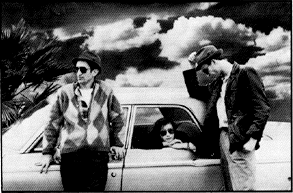September 28, 2003
wish it were so
"There is Hollywood and there are national cinemas."
Is there? I wish it were that simple.
I guess I tacitly accept this on one level, given my desire to see a national Australian cinema that gives expression to the questions that trouble us about our contemporary form of life.
Since I looked at Australian film in terms of it being nationalistically-minded, so I supported government financing of film production and the development of a small network of domestically owned and run distribution companies.
I gave up on Australian cinema to the extent it became equated with film industry rather than film texts. In national cinema as film industry the emphasis is on origin: where films find their financing, production and exhibition. My tacit emphasis was on Australian cinema as film text, which foregrounded issues of subject matter, style, representation.
So I was more interested in mid-budget films with socially relevant features (Bad Boy Bubby and Death in Brunswick); or more experimental films by independent film makers, such as Paul Cox, that were critically accepted. Then I sort of lost interest.
On the other hand, we have the internationalising culture as the mainstream US film industry shifted from a national cinema into the business of making international movies with simplistic uncontroversial stories, star names, emerging technologies, high-profile marketing and saturation booking. And then
Hollywood sets up production facilities in Australia because the low dollar and tax credits afforded them meant that the big studios could shoot their films at a fraction of U.S. budgets. That had the politicians falling over themselves in delight. What they could see was economic growth and jobs.
This cannot be called an Australian cinema.
What happened was that I found myself relating to films, such as those of Jim Jarmusch. I have in mind this director's films such as Stranger Than Paradise or Mystery Train and Dead Man. It was the imagery in Stranger than Paradise that seduced me:
 Yet this body of work is seen, and celebrated as being part of an American cinema in terms of story, characters and performances. It rejects the goal-oriented classical narrative and naturalistic acting styles of Hollywood and much Australian cinema, and it embraces formal minimalism and iconographic post-industrial landscapes.
Yet this body of work is seen, and celebrated as being part of an American cinema in terms of story, characters and performances. It rejects the goal-oriented classical narrative and naturalistic acting styles of Hollywood and much Australian cinema, and it embraces formal minimalism and iconographic post-industrial landscapes.
I felt far more at ease with this cinema that I did with the work of Paul Cox or Australian films such as Muriel's Wedding or Strictly Ballroom or Sweetie and Adventures of Priscilla Queen of the Desert. These worked in a space that celebrated 'quirkiness', 'eccentricity' and 'individuality'. They criticising the banality of everyday life, opened up its richness of contemporary, usually urban settings and culture, and broke away from the realist social problem filmmaking. Yet the filmic language was thin.
As I said, I wish it were as simple as there is Hollywood and there are national cinemas.
It is not that simple is it?